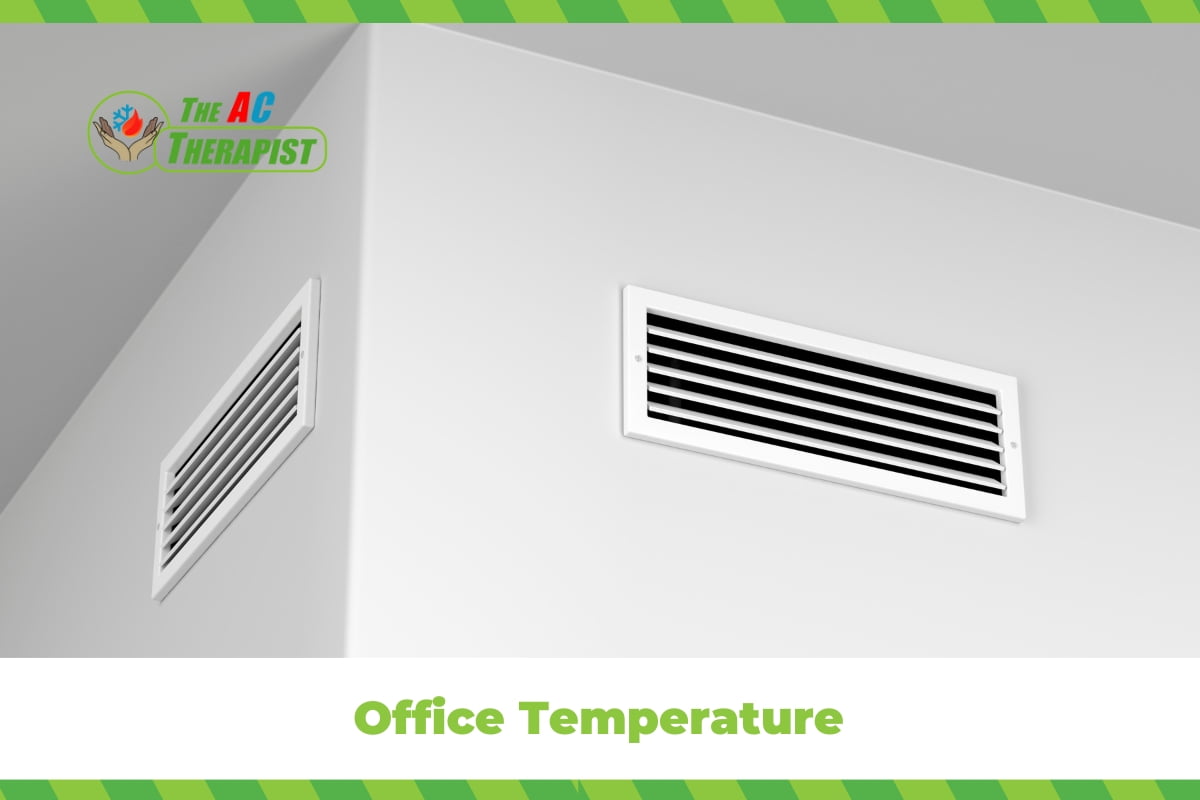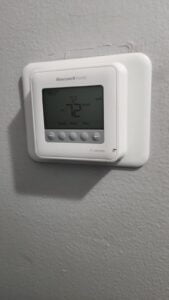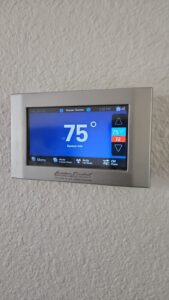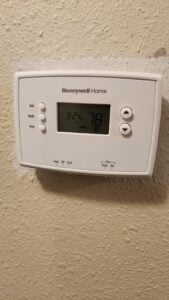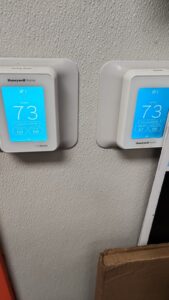Office Temperature
A comfortable office temperature is not merely a matter of personal preference but a vital component of a productive, healthy, and satisfying work environment. The quest for the ideal office temperature has long been a topic of debate and research, underscoring its significant impact on workplace dynamics. Temperature affects not only physical comfort but also plays a crucial role in cognitive function, directly influencing concentration, memory, and overall employee performance.
Studies have consistently shown that when office temperatures are too cold or too hot, productivity suffers, errors increase, and the health and well-being of employees are compromised. Issues such as increased fatigue decreased motivation, and higher levels of stress have been linked to environments that stray from the comfort zone. On the other hand, an optimal temperature setting can enhance worker satisfaction, reduce absenteeism, and foster a more energetic and engaged workforce.
Understanding and achieving the ideal office temperature is thus a strategic objective for organizations aiming to optimize their operational efficiency and cultivate a workplace culture that prioritizes the well-being of its employees. This introduction to the ideal office temperature explores its critical importance and sets the stage for a deeper dive into how it can be effectively managed for the benefit of all.
The Science Behind Comfortable Office Temperatures
The quest to determine the ideal office temperature is underpinned by a wealth of scientific research, which highlights the profound effect of environmental conditions on human performance and well-being. Numerous studies have endeavored to pinpoint the temperature range that maximizes productivity and comfort, shedding light on the complex relationship between thermal conditions and cognitive functions.
Key Research Findings
One of the most cited studies in this domain is the research conducted by Cornell University, which found that workers made 44% more errors and were half as productive when office temperatures were low (68°F or 20°C) compared to when temperatures were optimal (77°F or 25°C). This research underscores the direct correlation between warmer temperatures and reduced mistakes, suggesting that a slightly warmer office environment could significantly boost accuracy and efficiency.
Conversely, a study published in the “Occupational and Environmental Medicine” journal observed that high office temperatures (above 77°F or 25°C) could decrease productivity. Participants in these warmer conditions demonstrated a decrease in output and an increase in distraction levels. This indicates that there’s a delicate balance to strike – temperatures that are too high can be just as detrimental to performance as those that are too low.
Cognitive Function and Temperature
The impact of temperature on cognitive function is a key area of interest. Cognitive abilities such as focus, memory, and problem-solving skills are essential for most office tasks. Research from the Harvard T.H. Chan School of Public Health found that individuals working in well-ventilated offices with below-average levels of indoor pollutants and CO2 had significantly higher cognitive functioning scores compared to those in conventional office environments. This suggests that the quality of the office environment, including its temperature, plays a crucial role in cognitive performance.
Temperature variations affect the body’s thermoregulation processes, which in turn can distract the mind from task-focused activities. When the body expends energy to keep warm or cool down, less energy is available for concentration, problem-solving, and creative thinking. Moreover, thermal discomfort can increase stress levels, further impairing cognitive function and leading to decreased job satisfaction.
The Ideal Temperature Range
While pinpointing an exact temperature is challenging due to individual preferences and adaptability, the consensus among researchers leans towards a range of 70°F to 77°F (approximately 21°C to 25°C) as the ideal for office settings. This range appears to provide a comfortable environment for the majority, supporting optimal cognitive function and minimizing the energy diversion for bodily temperature regulation.
Fact 1 – The Ideal Temperature Range
Determining the ideal temperature range for office environments is crucial for fostering a comfortable and productive workspace. While individual preferences can vary widely, scientific research and workplace studies have converged on a temperature range that generally supports optimal performance and satisfaction for the majority of office workers.
Establishing the Range
The consensus among various studies points towards an ideal office temperature range of 70°F to 77°F (approximately 21°C to 25°C). This range is considered optimal for several reasons:
- Cognitive Performance: Within this temperature bracket, cognitive functions such as concentration, memory, and problem-solving are less likely to be impaired by physical discomfort. This is critical for tasks that require attention to detail and sustained focus.
- Comfort and Satisfaction: Thermal comfort is intrinsically linked to employee satisfaction. A temperature range that minimizes discomfort due to cold or heat can reduce distractions, allowing employees to focus better on their tasks. Comfortable temperatures also contribute to a positive office atmosphere, enhancing overall job satisfaction.
- Health and Well-being: Maintaining an office temperature within this range can also have health benefits. Temperatures that are too low or too high can contribute to various health issues, from common colds and respiratory problems to heat stress and dehydration. An optimal temperature range supports not just productivity but also the physical well-being of employees.
Adaptability and Flexibility
While the 70°F to 77°F range is broadly recommended, it’s essential to recognize the role of adaptability and flexibility in managing office temperatures. Factors such as clothing, personal preferences, the nature of the work being performed, and even the time of year can influence what individuals consider comfortable. For example, during the winter months, people may find slightly warmer temperatures more comfortable due to their clothing, whereas in the summer, a setting closer to the lower end of the range might be preferable.
Technological Aids
Modern office buildings often employ advanced HVAC systems capable of maintaining precise temperature settings and adapting to different zones within the building. Smart thermostats and other technological solutions can help manage the office temperature dynamically, taking into account external weather conditions, the number of people in a room, and even the time of day to ensure that the environment remains within the ideal range.
Fact 2 – Individual Preferences and Variability
A one-size-fits-all approach to office temperature can be a recipe for discomfort and dissatisfaction, given the wide range of individual preferences and physiological differences among employees. Understanding and accommodating these variances is crucial for creating an inclusive and productive work environment.
The Role of Personal Differences
Several factors contribute to individual differences in temperature preference, including:
- Metabolic Rate: People with higher metabolic rates generate more body heat and may prefer cooler temperatures, whereas those with lower metabolic rates might lean towards warmer settings.
- Clothing: The type and amount of clothing can significantly affect thermal comfort. Employees dressed in lighter, more breathable fabrics may have different temperature needs than those in heavier, warmer attire.
- Acclimatization: Individuals acclimatized to certain climatic conditions might find the same office temperature more or less comfortable depending on their backgrounds.
- Gender: Research suggests that, on average, women may prefer slightly warmer office temperatures than men, possibly due to differences in metabolic rate and body composition.
- Age: Age can also play a role in temperature preference, with older employees potentially preferring warmer conditions.
Strategies for Accommodation
To manage the diversity of temperature preferences effectively, employers can consider several strategies:
- Personal Control Options: Providing personal control options, such as desk fans, portable heaters, or adjustable vents, allows employees to fine-tune their immediate surroundings to their comfort levels.
- Flexible Dress Codes: Implementing flexible dress codes can enable employees to dress for their thermal comfort, within professional boundaries.
- Zoned Temperature Controls: Advanced HVAC systems with zoned controls can offer different temperature settings in various parts of the office, catering to groups with similar preferences.
- Thermal Surveys: Regularly conducting thermal comfort surveys can help employers understand the majority preference and adjust the general office temperature accordingly.
Encouraging Adaptation
While accommodating individual preferences is important, encouraging employees to adapt to a mutually agreeable temperature range is also beneficial. This might involve:
- Educating employees on the reasons behind the chosen temperature range, emphasizing its benefits for productivity and health.
- Encouraging the use of personal comfort items like blankets, personal fans, or heated mats can help individuals adjust without affecting the overall office temperature.
Fact 3 – The Role of Humidity
While the focus on finding the ideal office temperature is important, the role of humidity cannot be overlooked. Humidity, or the amount of water vapor in the air, plays a crucial role in how we perceive temperature and comfort. In the context of an office environment, both low and high humidity levels can significantly impact employee health, comfort, and productivity.
Understanding Humidity Levels
- Low Humidity: Air that is too dry can lead to discomfort and health issues such as dry skin, irritated eyes, and respiratory problems. It can also increase the likelihood of static electricity, which can damage electronic equipment. Low humidity makes cooler temperatures feel colder and can contribute to a feeling of chilliness in the office.
- High Humidity: Conversely, high humidity can make the environment feel stuffier and warmer than it is. Excessive moisture in the air can lead to sweating, which does not evaporate as efficiently, reducing the body’s ability to cool itself. This can result in a perceived higher temperature, making the workplace uncomfortably warm. Moreover, high humidity can encourage the growth of mold and mildew, potentially leading to health problems and damage to office materials.
Ideal Humidity Range
The optimal humidity range for indoor environments is generally considered to be between 30% and 60%. Maintaining humidity within this range helps ensure that the air is comfortable and reduces the likelihood of health issues or discomfort from too dry or too moist air.
Strategies for Managing Humidity
- Humidifiers and Dehumidifiers: Employing humidifiers in dry conditions and dehumidifiers in moist conditions can help maintain the humidity level within the ideal range, enhancing comfort and health.
- Proper Ventilation: Ensuring adequate ventilation in the office can help control humidity levels, improve air quality, and reduce the concentration of pollutants and allergens.
- Regular Maintenance: HVAC systems should be regularly maintained to ensure they are functioning properly and efficiently managing both temperature and humidity.
- Indoor Plants: Adding indoor plants can help regulate humidity levels, as plants naturally release water vapor during transpiration, contributing to a more comfortable office environment.
The Impact of Humidity on Perceived Temperature
It’s important to note that humidity affects the thermal comfort zone. For instance, at higher humidity levels, a lower temperature might be preferred to offset the muggy feeling, whereas in dry conditions, a slightly higher temperature might feel more comfortable. Adjusting the office temperature based on humidity levels can help maintain a consistently comfortable environment.
Fact 4 – Seasonal Adjustments
Adapting office temperature settings in response to seasonal changes is crucial for maintaining an optimal working environment year-round. Seasonal adjustments account for variations in external temperatures, changes in clothing, and the different ways our bodies perceive comfort across seasons. Implementing strategic changes can significantly enhance employee comfort and productivity, regardless of the weather outside.
The Importance of Seasonal Adaptability
- Winter: In colder months, the body conserves heat, and individuals tend to wear heavier clothing. As a result, office temperatures might need to be adjusted slightly higher to compensate for the cooler external temperatures and to counteract the heat loss through building exteriors. However, overheating should be avoided to prevent a stuffy and uncomfortable environment.
- Summer: During warmer months, the opposite is true. The body attempts to cool down, and lighter clothing is common, necessitating a cooler office temperature to remain comfortable. Air conditioning systems become crucial in managing indoor temperatures and ensuring that humidity levels stay within the comfortable range.
Adjusting for Employee Comfort
- Flexible Temperature Settings: Employers can adopt more flexible temperature settings during transitional seasons like spring and fall when external temperatures can fluctuate significantly. This flexibility helps accommodate personal comfort levels as employees adjust to the changing weather.
- Utilizing Natural Ventilation: Whenever possible, natural ventilation should be used to enhance indoor air quality and regulate temperature. Opening windows can help balance indoor and outdoor temperatures during mild weather, providing a natural and energy-efficient cooling solution.
Energy Efficiency and Sustainability
Seasonal adjustments also present an opportunity to improve energy efficiency and sustainability in office buildings. For instance:
- Smart Thermostats: These can automatically adjust temperature settings based on the time of day and external weather conditions, optimizing energy use while maintaining comfort.
- Window Treatments: Employing blinds or shades can reduce heat gain during summer and heat loss during winter, supporting the HVAC system in maintaining desired temperatures more efficiently.
Employee Health and Well-Being
Seasonal changes in office temperature also have implications for employee health. During winter, drier air can increase susceptibility to colds and flu, making it important to maintain adequate humidity levels. In contrast, summer months require vigilance against overheating and dehydration, emphasizing the need for accessible hydration stations and well-maintained cooling systems.
Fact 5 – Technological Solutions for Temperature Control
In the modern workplace, technological advancements have revolutionized the way we manage and control office temperatures, offering sophisticated solutions to maintain optimal comfort and energy efficiency. These technologies not only provide precise temperature control but also adapt to individual preferences and environmental changes, ensuring a consistently comfortable office environment.
Smart Thermostats
Smart thermostats stand at the forefront of temperature control technology. These devices learn from your habits and adjust the temperature automatically for optimal comfort and energy savings. They can be programmed to change settings based on the time of day, occupancy, and even the weather outside, ensuring the office is always at a comfortable temperature without wasting energy. Some smart thermostats also offer remote control via smartphones or computers, allowing adjustments to be made even when away from the office.
Zoned HVAC Systems
Zoned Heating, Ventilation, and Air Conditioning (HVAC) systems allow different areas of an office to be heated or cooled independently. This is particularly useful in buildings where different sections have varying exposure to sunlight, occupancy levels, or specific equipment that generates heat. Zoned systems help address individual comfort preferences and reduce energy consumption by only targeting areas that need temperature adjustments.
Occupancy Sensors
Occupancy sensors automate temperature control by detecting the presence of people in a room and adjusting the HVAC system accordingly. When a room is empty, the system can lower heating or cooling to save energy. This technology ensures that energy is not wasted on unoccupied spaces, while still maintaining comfort levels in areas with occupants.
Advanced Building Materials
The use of advanced building materials in office construction can also play a significant role in temperature control. Materials with high thermal mass or insulation properties help maintain stable indoor temperatures by reducing heat gain during summer and heat loss during winter. Windows coated with low-emissivity (low-E) films can minimize the amount of infrared and ultraviolet light that enters the office, keeping it cooler in summer and warmer in winter without sacrificing natural light.
Personal Heating and Cooling Devices
For addressing individual preferences, personal heating and cooling devices, such as under-desk heaters or desktop air conditioners, offer a solution. These devices allow employees to adjust their immediate surroundings to their comfort level without affecting the overall office temperature. This approach can help resolve conflicts over thermostat settings and enhance individual comfort and productivity.
Finding the Sweet Spot: The Ideal Office Temperature for Peak Performance
At The AC Therapist, we understand the importance of creating a comfortable and productive workspace through optimal temperature control. The journey to finding the ideal office temperature is guided by a blend of scientific research, technological innovation, and consideration of individual comfort preferences. From the insights provided in this blog, it’s clear that maintaining a temperature range of 70°F to 77°F, adjusting for seasonal variations, and accommodating personal differences are key to fostering a work environment that promotes health, satisfaction, and efficiency.
In today’s advanced workplace, leveraging technology such as smart thermostats, zoned HVAC systems, and occupancy sensors can significantly enhance our ability to achieve and maintain the perfect office climate. These tools not only cater to the diverse needs of employees but also contribute to energy conservation and operational efficiency.
At The AC Therapist, we are committed to ensuring that your office remains a bastion of comfort and productivity. Whether it’s through regular maintenance of your HVAC systems, installation of the latest climate control technologies, or providing personalized solutions for your unique office layout, we are here to help you navigate the complexities of office temperature control.
Remember, the ideal office temperature is not just about numbers on a thermostat; it’s about creating an environment where employees feel valued, comfortable, and motivated to achieve their best. Embrace the challenge of finding your office’s sweet spot, and enjoy the benefits of a happier, healthier, and more productive workplace.

